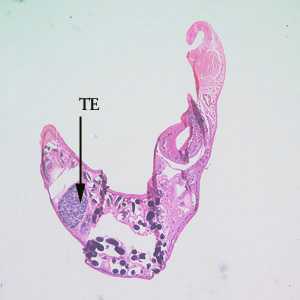
Case #224 - March, 2008
A 47-year-old male with travel history to the Galapagos Islands, Ecuador and Colombia presented to his health care provider with follicular conjunctivitis. A worm-like object measuring approximately 3.0 mm was removed from his eye and sent to a pathology laboratory for analysis. The object was sectioned, stained with hematoxylin and eosin (H&E) and examined microscopically. Figure A shows the object at 40x magnification; Figure B shows a close-up of one end of the object at 100x magnification. What is your diagnosis? Based on what criteria?

Image A

Image B
Case Answer
This was a case of conjunctivitis caused by an eye fluke in the genus, Philophthalmus. Diagnostic features were:
- the presence of an oral sucker (OS, Figure B) at the anterior end of the worm.
- the presence of a ventral sucker, or acetabulum, (AC, Figure B) near the mid-section.
- the presence of a prominent pharynx (PH, Figure B).
- the presence of testes at the posterior end of the worm, one of which is visible in Figure A (TE).
- location in the host (eye).

Figure A

Figure B
Philophthalmus is a genus of flukes found primarily in birds; various species commonly infect either the intestinal tract or eye. There are several documented cases of eye infection in humans. Eggs are laid in the eye of the definitive host and pass into water via the tear ducts, where miracidia hatch and find a suitable snail intermediate host. Cercaria leave the snail and encyst on objects in the water, including vegetation. The definitive host is infected by ingestion of vegetation containing encysted metacercariae or direct contact with water containing infective cercariae that are introduced into the eyes. Most human cases are related to swimming or bathing in contaminated water.
More on: Philophthalmiasis
Images presented in the monthly case studies are from specimens submitted for diagnosis or archiving. On rare occasions, clinical histories given may be partly fictitious.
DPDx is an education resource designed for health professionals and laboratory scientists. For an overview including prevention and control visit www.cdc.gov/parasites/.
- Page last reviewed: August 24, 2016
- Page last updated: August 24, 2016
- Content source:
- Global Health – Division of Parasitic Diseases and Malaria
- Notice: Linking to a non-federal site does not constitute an endorsement by HHS, CDC or any of its employees of the sponsors or the information and products presented on the site.
- Maintained By:


 ShareCompartir
ShareCompartir